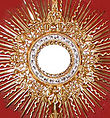Maria Candida of the Eucharist
Saint Peter's Square, Vatican City by Pope John Paul II | |
|---|---|
| Feast |
|
| Attributes | Carmelite habit |
| Part of a series on |
| Christian mysticism |
|---|
 |
| Part of a series on |
| Eucharistic adoration of the Catholic Church |
|---|
 |
| Papal documents |
| Organisations and events |
|
| Notable individuals |
| Eucharistic meditators |
|
|
Catholicism portal |
Maria Candida of the Eucharist (born Maria Barba; 16 January 1884 – 12 June 1949) was an
The beatification process opened on 15 October 1981 and she became titled as a
Life
Maria Barba was born on 16 January 1884 in
In 1891 she began her time at school and achieved excellent grades while there; she completed her studies in 1898. That same year she began to learn the piano. On 3 April 1894 she made her
Her father died on 21 June 1904. In September 1910 she and her mother and siblings undertook a pilgrimage to
Barba waited for two decades before she could enter the order's
On 19 June 1933 - the feast of Corpus Christi - the nun began writing the book that served as a record of her own personal experiences and reflections on Eucharistic meditations and this was completed in 1936.[2] The book also records deepening theological reflections on those personal experiences of hers.[1] On 16 June 1922 she had starting writing "Up: First Steps" on her vocation and arrival to the order while later on 5 November 1926 beginning "Mountain Song" at the request of her confessor on her Carmelite life.[4]
Barba was first diagnosed with a tumor in her liver back in 1947. She died of cancer on the evening of 12 June 1949 and her remains were interred at Ragusa the following 14 June. [4][5] Her remains were later relocated on 12 November 1970.
Beatification
The beatification process opened in Ragusa in an informative process that Bishop Francesco Pennisi oversaw from its inauguration on 5 March 1956 until its closure later on 28 June 1962; the formal introduction to the cause came on 15 October 1981 in which she became titled as a
The process for a miracle needed for beatification was investigated in the place of its origin from 12 June 1986 until 9 December 1986 while the C.C.S. later validated the process on 26 March 1993 in Rome. Medical experts approved this healing to be a legitimate miracle on 23 May 2002 as did theologians on 13 December 2002 and the C.C.S. themselves on 4 March 2003. John Paul II approved this miracle on 12 April 2003 and later beatified Barba on 21 March 2004 in
The current postulator for the cause is the Discalced Carmelite priest Romano Gambalunga.
Quotations
In her book she related devotions to the
Among her other statements:
- O my Beloved Sacrament, I see You, I believe in You! O Holy Faith. Contemplate with ever-greater faith our Dear Lord in the Sacrament: live with Him who comes to us every day.
- O My Divine Eucharist, my dear Hope, all our hope is in You. Ever since I was a baby my hope in the Holy Eucharist has been strong.
- My Jesus, how I love You! There is within my heart an enormous love for You, O Sacramental Love. How great is the love of God made bread for our souls, who becomes a prisoner for me![2]
Publications
- Up: First Steps - 1922.
- Mountain Song - 1926.
- The Eucharist: True Jewel of Eucharistic Spirituality - 1936.
See also
- Alexandrina of Balazar
- Concepción Cabrera de Armida
References
- ^ a b c d e "Maria Candida of the Eucharist (1884-1949)". Holy See News Services. Retrieved 12 December 2016.
- ^ a b c d e "Blessed Maria Candida of the Eucharist". Saints SQPN. 6 June 2015. Retrieved 12 December 2016.
- ^ a b c d "Blessed Maria Candida of the Eucharist". Santi e Beati. Retrieved 12 December 2016.
- ^ a b c d e f "Blessed Maria Candida of the Eucharist". UCAN. Retrieved 12 December 2016.
- ^ a b "Bl. Maria Candida of the Eucharist, Virgin, OCD". OCDS. 18 December 2008. Retrieved 12 December 2016.
- ^ ""Bl. Maria Candida of the Eucharist OCD", Order of Crmelites". Archived from the original on 2012-07-20. Retrieved 2015-10-10.
